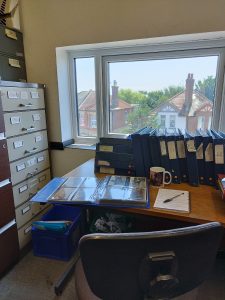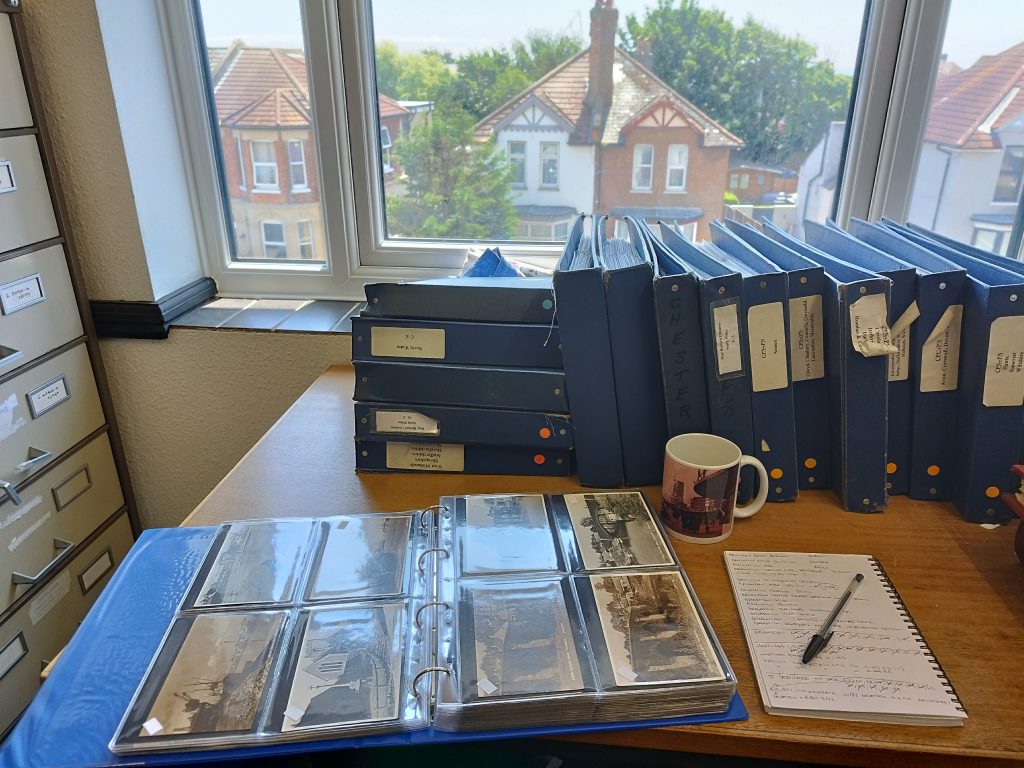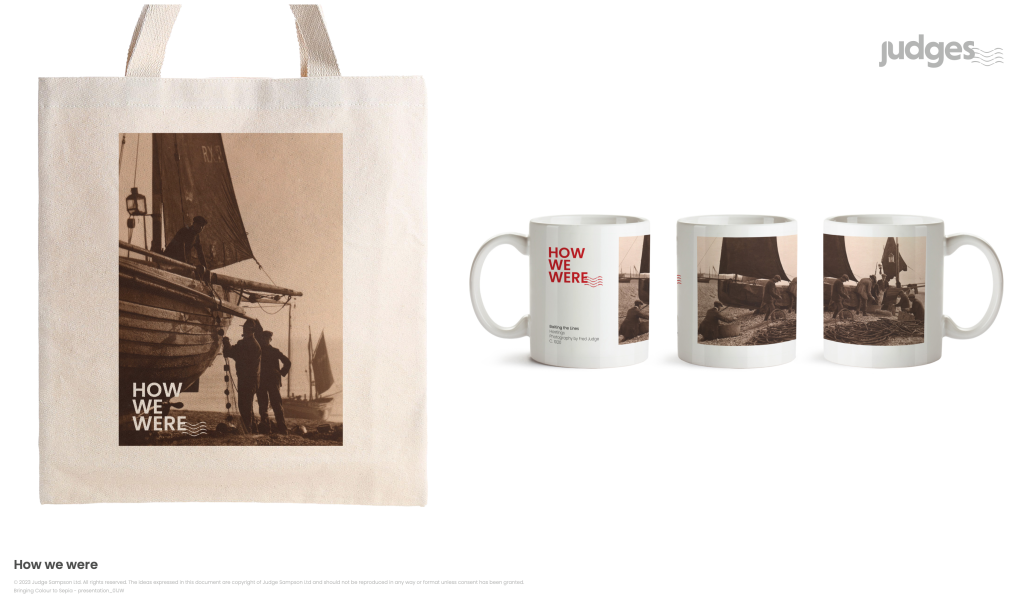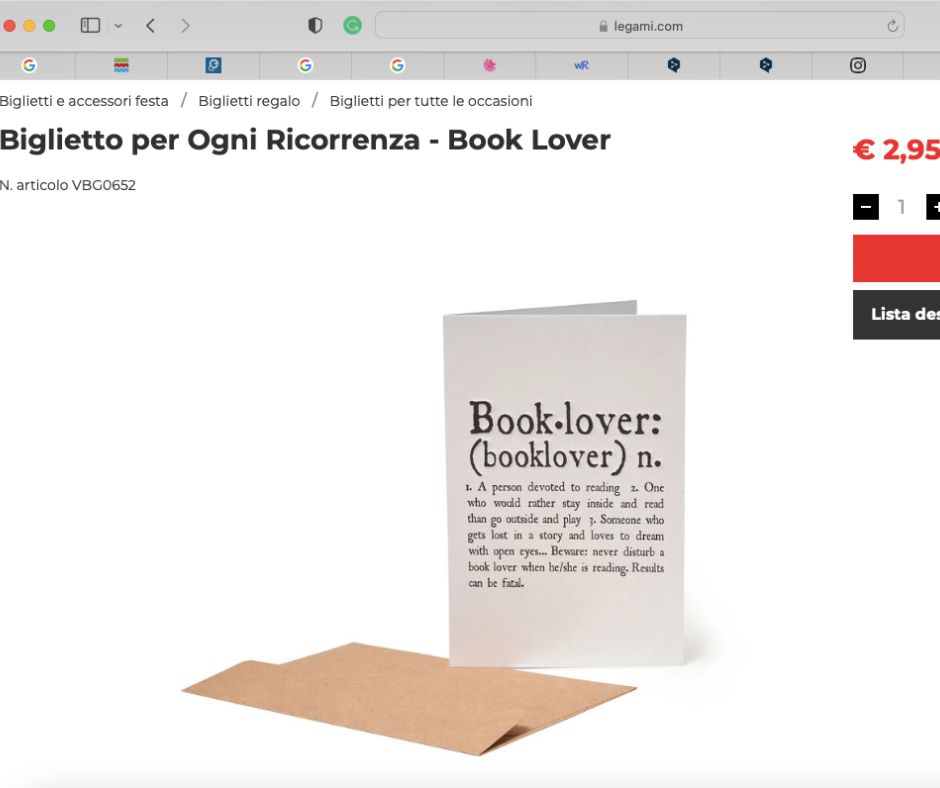By Ilenia Atzori, Karina Rodriguez
During the Summer of 2023, the Digital Skills in Visual and Material Culture at the University of Brighton, in collaboration with Judges Ltd, a company in Hastings with an archive of postcards and photographs encompassing more than 100 years of history, hosted an internship to develop the creative and digital skills in managing visual archival data and proposing creative deployment of images for commercial use of a researcher in the Arts, Design or Humanities.
Supervised by the company’s managing director and Karina Rodriguez Echavarria, Reader at the School of Architecture, Engineering and Mathematics, and working closely with the company’s designers, Ilenia Atzori (2nd year PhD student, School of Art and Media) researched and evaluated the images of the company’s archive, suggested how they could be marketed to access new customers, proposed the introduction of a Digital Asset Management (DAM) System and looked at competitors’ offers.
During the project, the candidate gained insight into the use of metadata and DAM Systems, had a better understanding of how to work with archive materials and gained basic notions on the conservation of films, as well as acquired basic notions on copyright.
SHORT HISTORY OF THE COMPANY
By the first decade of the 20th century, postcards had become a popular means of communication (and items to be collected), after their appearance in Great Britain around the 1870s. Amongst Fred Judge’s subjects, who founded his illustrated postcards production company in Hastings in 1902, were not only landscapes but also events that were meaningful in the life of the local community, which allowed his works to be featured in local newspapers in a time when rarely the press used photographs to illustrate stories.
Over the years, successful business management and technological changes in the production of postcards led to the company moving to its current location in a new purpose-built building in 1927; except for the extensions in the back, the overall layout of the building is still the same.
With the outbreak of World War 2, production ceased as the employees were in the armed forces; yet the company survived thanks to the large stocks that had previously been built up. In those years, Ernest (Bart) Bartholomew had joined the RAF as a photographer, after being made an Associate of the Royal Photographic Society in 1940. At the end of the war, he rejoined the company and helped with its reorganisation, before becoming the new Managing Director and Chairman of the Judges from 1952 (following Fred Judge’s passing away in 1950) to 1982, when he retired.
Between the late 1950s and early 1960s, the business needed to be streamlined and experiments began with the first coloured card, produced from black and white photographs and coloured in oils. At the same time, while the sepia and black and white postcard production ceased, a single-colour litho printing press was introduced which led to the production of other items alongside postcards, such as Christmas cards, calendars and boxed picture notes.
At the end of 1982, Bartholomew decided to retire and in December the same year the shares of the company were purchased by a toy manufacturer from Cambridge, Peter Pugh, who later asked Bernard Walford to manage the Judges. Following some financial difficulties, Walford decided to mount a rescue bid to allow the company to survive and created the Judges Postcards Ltd, which was back at work with all staff re-employed.
In the late 1980s, Walford’s two sons Graeme and Trevor joined the company, later becoming respectively the Production Director and Sales and Marketing Director of the company. Technology changes in the 1990s allowed the company to introduce servers and computer stations which led to the opportunity to digitally store and retouch the photographs, improving the business’ cost-effectiveness and range of products.
THE CURRENT SITUATION
The Judges’ physical archive consists of more than 30,000 postcards and photographs. The early sepia as well as black and white images were created by Fred Judges who founded The Judges business in 1902. Fred Judges was born in 1872 and passed away in 1950. Later colour photographs were created by Ernest Bartholomew (died c. 2010), then owner of Judges, or Bernard Wolford, as well as his employees and sons, current owners of the Judges.
In the early 2000s, 13,000 of the early sepia/black and white photographs were scanned and made available. These images are mostly organised by location, and the web interface offers a basic search function. Images on the website are watermarked. In the past, the company tried to create new products using images from this archive with limited success. Moreover, the current digital setup consists of a shared folder structure organising the images by location. This shared resource is available to the team of designers when creating new souvenirs for the company’s shop.
However, this solution for sharing the images presents some limitations:
- The images are not searchable, which implies time-consuming research when trying to locate images that might be relevant to design projects.
- Each photograph is accompanied by insufficient metadata, including copyright information.
THE PROJECT DEVELOPMENTS: THE ARCHIVE AND TOPICS
The project involved looking at the physical archive to understand the potential for the collection’s uniqueness and reusability for the creation of customised products to be sold in the Judges’ shop. The physical archive, based in a dedicated space at the company’s premises, consists of different pocket folders organised by location, containing approximately 9 sepia or black and white postcards per page spanning from the early 1900s to the 1960s and 1970s, as well as a number of filing cabinets containing later colour postcard samples on the one hand, and more contemporary colour photographs or transparencies on the other.



From a historical point of view, one of the most interesting aspects of the collection is the cross-section of life in the United Kingdom offered by the photographs: some of them portray jobs, objects, or craftsmanship that either do not exist anymore or have evolved thanks to the still ongoing development of research and technology. An example can be the oyster seller in Blackpool, or the bathing carriages in Hastings’ seafront, as well as the lobstermen on Eastbourne’s seafront preparing his fishing traps. The collection also offers a history of fashion, urban and rural landscapes, but also buildings, especially considering the changes brought about by World War 2 and the London-Blitz, operated by the German Airforce between 1940 and 1941. For instance, the collection includes photographs of Jack Straw’s Castle, in Hampstead, London, before (1937, postcard n. 19263, London North) and after (1966, postcard n. 30801, London North) the Blitz.
During the project, we worked with the team to understand how the images could be creatively repurposed for developing products that appeal to the Judges’ market beyond simply reproducing them. We identified various design themes for reusing and reinterpreting the collection, including “visions of times” by combining historic photographs of locations and their current layouts, as well as others, including vintage fashion, cars, and aircraft. In addition, new digital techniques could be applied to create poster art, for instance, stylisation reworks of sepias (e.g.: van Gogh, Monet, Picasso, etc.), colourisation, as well as creating designs which combine various images, not necessarily from the same period, such as, for instance, in the Bayeux Tapestry style.


Image 1. Example of designs by James White: Who we were © 2023 Judge Sampson Ltd.
The selection of images could be by location or thematic according to the product that is being developed. As technology improves, tools which are already used in the business, such as Adobe Photoshop, will be able to produce these images. For instance, following the latest update, Adobe Photoshop allows to automatically add colour to sepia photographs with the help of AI, and the best results can currently be obtained with images from the 1950s. In the designers’ opinion, this is very likely due to the higher level of detail and sharper imagery. However, being this AI tool is still in its infancy, it would be better to wait at least one year before being able to obtain much better results. Another point raised by the designers is the need to choose iconic images and locations where subjects interact with their environment because this would facilitate an emotional connection between customers and the items at sale. In addition, they think that digital collages of cities’ landmarks could be another good-selling idea.
LOOKING AT ALTERNATIVE OFFERINGS
The project also involved a web scoping activity to look for potential international competitors with similar characteristics. This was a particularly difficult task because none of the businesses identified, except for Francis Frith’s (www.francisfrith.com) which however was not included in the scoping activity, have and use historical archives of photographs that they also share online. Therefore, this activity was focused on businesses that sell souvenirs, stationery, postcards and other items such as tote bags or gift ideas. The companies identified are based in Italy, France, the United Kingdom, Belgium and Denmark. These companies are included in Annex 1.
To promote their products to a wider audience, all of them have at least an Instagram account, and almost all of them also have a Facebook account. Other social media used by these companies are Pinterest, Vimeo, YouTube and Twitter. Looking into these companies’ websites and social media accounts sparked some reflections. For instance, the French company Marcel Travel Posters (https://marcel-travelposters.com/en) has as a ‘theme’ section, presenting the different designs available organised per theme; the Belgian company Le Typographe, instead, offers a ‘price range’ search option (see: https://www.typographe.be/en/product-category/folded-card-envelope/); the latter, combined with other options like, for instance, size, colour and design (or location) could be a good idea to consider for the Judges’ website. Another interesting characteristic presented by the French Brittany Tourism’s (https://www.brittanytourism.com/matching-what-i-want/ideas/souvenirs-made-in-brittany/) and the Danish Forindet’s (see “Keeping it green” at https://forindet.com and “The Process” at https://forindet.com/about/#the_story_sec) websites[KE6] was the stories behind their products: this can make customers empathise more with the company and with the products offered, and therefore might be a good idea – in case it has not been implemented yet.
During this scoping activity, one of the designs by Studio Saòr (Venice, Italy), sparked another potential idea for a design to be used by the Judges. A tote bag produced by this company features the ‘vaporetto’, one of the iconic Venetian boats, and all the stops from line 1 (https://studiosaor.com/product/vaporetto-tote-bag/). Therefore, if considered appealing to the public, another potential idea for the Judges could be using the items in their photographic collection that may not exist anymore (e.g.: bathing carriages) and combining them with a definition, as in the following example from the Italian company Legami (Image 2).

Image 2. Screenshot from Legami website (https://www.legami.com/en_en/) © 2023 Legami
DIGITAL ASSET MANAGEMENT (DAM) SYSTEM
Furthermore, the project looked at potential solutions to overcome some of the main limitations with regards to managing such a large number of images, along with their metadata by identifying functionalities which are offered by Digital Asset Management Systems. Considering the current limitations of the setup for sharing files, as well as the needs of the designers in order to optimise their work the best option for the Judges would be to invest in a Digital Asset Management (DAM) System.
Digital Asset Management (DAM) software is a tool that helps organisations store, organise, and distribute their digital assets such as images, documents, videos, and other media files. Thanks to AI auto-tagging, it also allows users to easily search, retrieve, and share their assets, ensuring brand consistency across multiple channels.
DAM software can be of two types: cloud-based and on-premises solutions. While on-premises solutions provide greater control and security, cloud-based DAM software offers remote accessibility, flexibility, scalability, and cost-effectiveness. When considering the adoption of DAM software, it is also important to consider whether to opt for a proprietary or an open-source solution. A Gartner survey shows that around 90% of organizations depend on open-source components in their functioning; this is because most outright proprietary digital asset management solutions are built explicitly to gel only with other proprietary software offered by the same vendor and not with other software solutions in the market. On the other hand, besides providing a single repository for images and other audiovisual content, as well as other digital media and their respective metadata, an open-source best DAM system comes with APIs that provide excellent interoperability with any 3rd party software.
INTRODUCING A DIGITAL ASSET MANAGEMENT SYSTEM
In order to introduce a DAM into the business, it is recommended to set up an internal project supported either by an external team or additional trained staff. In particular, it is necessary to have expertise in data management systems, as this will make it more cost-effective, avoid time-consuming research, and produce a result which fits the business needs and process. For example, one of the requirements for the current digital archive to be improved is to add more metadata to each digitised image.
The process for introducing a DAM will involve going through each photograph to complete all the basic information needed and manually/semi-automatically adding the tags based on their visual observation. In addition, it would be recommended to use standardised information from controlled vocabularies, “an organized arrangement of words and phrases used to index content and/or to retrieve content through browsing or searching” (www.getty.edu).
Metadata should include at least the basic information that should be associated with each image (see example in Table 1). Some of this metadata could potentially be automatically identified by a Machine Learning algorithm as it is already tested by large-scale archives (see Blog: https://culturedigitalskills.org/news/ai-methods-large-scale-images).
| Field | Description | Example |
| ID | Unique identification | 001 |
| Name | If not already given, a format should be defined | Albert memorial 58 |
| Date | When the photograph was created | Early 1900s |
| Author of the photograph | If known | Fred Judge |
| Source | E.g.: postcard, transparency, other | Postcard |
| Stored | The physical location where the item is found | Judges 1 data digital archive |
| Depicts | What it depicts | Albert Memorial and Hastings city life in the early 1900s |
| Tags | Other information that might be searched by designers to create new products (e.g.: “fashion”, “children playing”, “vintage cars”, “old trades”, etc.). This information is based on what is depicted in the photograph and what may be useful for the designers to develop a pattern or a new idea. | An example could be the following: Hastings; city life; fashion; Albert Memorial; history; lost monuments; architecture; clock tower; town centre; vintage urban landscape; shops; sepia. This was created with a combination of observation and the use of AAT database for the controlled vocabulary related to the type of photographs. |
| Location depicted | This information should be added from the Geonames database, “a geographical database under a Creative Commons Attribution license”. Every location has a unique ID that easily allows to search and retrieve all the photographs and/or postcards from the same location. | |
| Material of the source | This information should be added from the AAT – Art and Architecture thesaurus database, “a structured vocabulary for describing and indexing the visual arts and architecture”. Every term has a unique description and is put in relation with other terms for the same category. | |
| Copyright | This information should describe who owns the copyright of the digital image. For instance, in the public domain if out of copyright. | Public domain |
| Collection/Series | In case photographs are part of a series, for instance |
LESSONS LEARNED
Before this placement, Ilenia had already worked as a consultant in the field of digital communication and had built her competencies in handling material culture both working as a tour guide and researching archives for her PhD project. The PhD research focuses on the relationship between the community living and working in Castello, one of the 4 historic districts of Cagliari (Italy), and their own heritage.
This placement, though, enhanced her competencies and created new ones. For instance, she had no experience with the creative reuse of visual and material culture. Understanding people’s perception of cultural heritage and how they interact with it is at the core of her project; however, the methods that she uses mostly involve interviews and participatory workshops with the community. This placement expanded her view to explore new kinds of engagement and ideas for new products, including those which can appeal to customers, thus generating an income.
In addition, she learned more about the importance of metadata and its use. This includes the use of metadata to improve and optimise certain data-driven business processes as well as research data. As a result, she is now planning to improve the metadata linked to her research archive of historical documents about a building in Cagliari, where her research is based. This will make them easier to retrieve, as well as ensure she has the relevant permissions to include in her research outputs.

